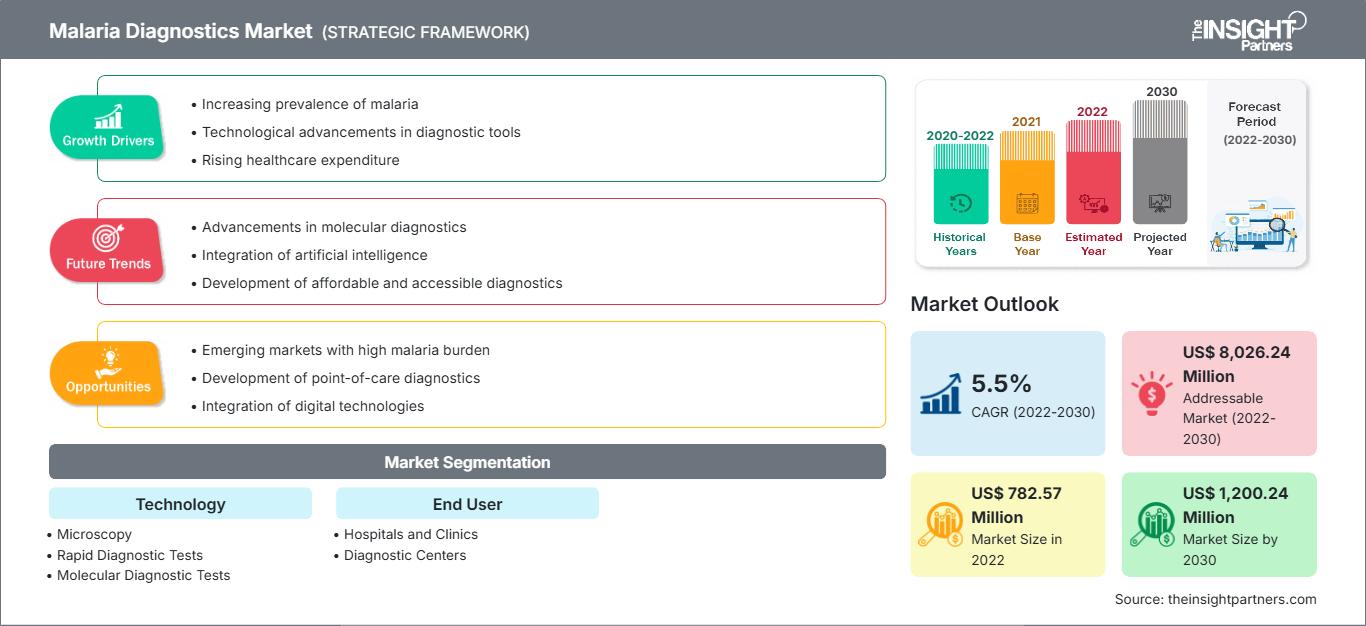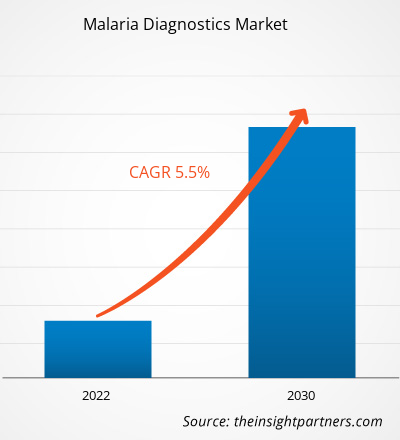[Informe de investigación] Se proyecta que el tamaño del mercado de diagnóstico de malaria crezca de US$ 782,57 millones en 2022 a US$ 1.200,24 millones en 2030; se estima que el mercado registrará una CAGR del 5,5% durante 2022-2030.
Perspectivas del mercado y opinión de los analistas:
La malaria es una enfermedad potencialmente mortal causada por el parásito Plasmodium. El mercado de diagnóstico de la malaria está en crecimiento debido a la alta incidencia de la enfermedad en países de bajos ingresos y a los programas de eliminación de la malaria implementados a nivel mundial por organizaciones internacionales y nacionales. El creciente lanzamiento de herramientas de diagnóstico avanzadas y el aumento de la investigación para terapias eficaces contribuyen aún más al crecimiento del mercado.
Antes de la pandemia de COVID-19, casi un tercio de los países endémicos avanzaban hacia los objetivos internacionales. Muchos países con baja incidencia formaban parte de la "Iniciativa de Eliminación 2025" de la OMS, representada por un grupo de 25 países que se esfuerzan por eliminar la malaria para 2025. Por otro lado, el progreso se estancó en aproximadamente un tercio de los países, mientras que en los demás países, la incidencia de la malaria aumentó. Los países con mayor carga de enfermedad se muestran más inclinados a utilizar los datos de las pruebas diagnósticas para estratificar y enfocar las intervenciones geográficamente adecuadas, independientemente de la importancia que siguen teniendo las pruebas y el cribado en los esfuerzos de erradicación.
Los casos y las muertes por malaria aumentaron durante el primer año de la epidemia de COVID-19 debido a pequeñas interrupciones en la gestión de casos y las medidas preventivas. No obstante, se evitó el peor escenario posible —la duplicación de las muertes por malaria— gracias a la cooperación de la OMS, los Programas Nacionales contra la Malaria y sus socios. Esto se debió a las dificultades para obtener los suministros necesarios contra la malaria y a la incertidumbre sobre cómo la pandemia afectó finalmente las medidas de gestión de la malaria.
Factores impulsores del crecimiento:
La malaria, una de las enfermedades febriles agudas, es causada por parásitos plasmodium y se propaga a través de los mosquitos Anopheles hembra infectados. Cinco especies de parásitos en humanos causan principalmente malaria, y dos de estas especies, Plasmodium falciparum y P. vivax, se consideran la mayor amenaza. Además, P. falciparum es el parásito de la malaria más mortal y está más ampliamente extendido en el continente africano. Además, P. vivax es el parásito de la malaria dominante en la mayoría de los países fuera del África subsahariana. Según el Informe Mundial sobre la Malaria (WMR) 2020 de la Organización Mundial de la Salud (OMS), se notificaron 241 millones de casos de malaria en todo el mundo, en comparación con los 227 millones de casos registrados en 2019. Según la misma fuente, el número de muertes causadas por la malaria aumenta en 69.000 al año. Aproximadamente dos tercios de estas muertes, es decir, 47.000, fueron causadas por interrupciones en los servicios de atención médica durante la pandemia de COVID-19; El tercio restante de muertes, es decir, 22.000, reflejó un cambio reciente en la metodología de la OMS para calcular la mortalidad por malaria (independientemente de las interrupciones causadas por la COVID-19).
En 2020, aproximadamente el 95 % de los casos y el 96 % de las muertes a nivel mundial por malaria se registraron en la región africana de la OMS, y aproximadamente el 80 % del total de muertes reportadas correspondió a niños de 5 años o menos. Según el Informe Mundial de Malaria (WMR) de 2021, aproximadamente el 2 % de la carga mundial de malaria se registró en países del Sudeste Asiático, donde India representó el 83 % de los casos estimados de malaria y el 82 % de las muertes asociadas a la enfermedad en 2020. Por lo tanto, el aumento de la prevalencia de la malaria en diferentes regiones del mundo impulsa el crecimiento del mercado de diagnóstico de la malaria.
Existe un número limitado de productos precalificados por la OMS que no son mRDT de Pf disponibles en el mercado. A pesar de la disponibilidad de una amplia gama de productos mRDT precalificados por la OMS, la demanda se concentra en un subconjunto preferente de productos y fabricantes específicos. Esto limita la capacidad del mercado para garantizar la diversidad, la seguridad y la capacidad de producción del suministro. En consecuencia, los fabricantes se enfrentan a desafíos como la baja demanda de productos en algunos países, así como su reticencia y falta de interés en adoptar productos alternativos. La adopción de marcas alternativas puede verse impulsada por cambios en las marcas seleccionadas para los algoritmos nacionales o por las implicaciones de costos.
Obtendrá personalización en cualquier informe, sin cargo, incluidas partes de este informe o análisis a nivel de país, paquete de datos de Excel, así como también grandes ofertas y descuentos para empresas emergentes y universidades.
Mercado de diagnóstico de malaria: perspectivas estratégicas

-
Obtenga las principales tendencias clave del mercado de este informe.Esta muestra GRATUITA incluirá análisis de datos, desde tendencias del mercado hasta estimaciones y pronósticos.
Segmentación y alcance del informe:
El mercado de diagnóstico de malaria se segmenta según la tecnología y el usuario final. Por tecnología, se divide en microscopía, pruebas de diagnóstico rápido (PDR) y pruebas de diagnóstico molecular. El segmento de pruebas de diagnóstico rápido (PDR) tuvo la mayor participación de mercado en 2022 y se estima que registrará la tasa de crecimiento anual compuesta (TCAC) más alta del mercado durante el período 2022-2030. El mercado de diagnóstico de malaria, por usuario final, se divide en hospitales y clínicas, centros de diagnóstico y otros. El segmento de hospitales y clínicas tuvo la mayor participación de mercado en 2022. Se espera que el segmento de centros de diagnóstico registre la TCAC más alta del mercado durante el período 2022-2030.
Análisis segmentario:
El mercado de diagnóstico de malaria, por tecnología, está segmentado en microscopía, pruebas de diagnóstico rápido (RDT) y pruebas de diagnóstico molecular.
El segmento de pruebas de diagnóstico rápido (PDR) tuvo la mayor participación de mercado en 2022 y se proyecta que registre la tasa de crecimiento anual compuesta (TCAC) más alta del mercado durante el período 2022-2030. Al demostrar la presencia de parásitos de la malaria en sangre humana, las pruebas de diagnóstico rápido (PDR) facilitan el diagnóstico de la malaria. Las PDR ofrecen una alternativa al diagnóstico clínico o la microscopía, especialmente en situaciones donde el acceso a servicios de microscopía de alta calidad es limitado. Plasmodium falciparum o P. vivax es la única especie que ciertas PDR pueden identificar, pero otras pueden identificar cuatro especies: P. falciparum, P. vivax, P. malariae y P. ovale. Generalmente, se utiliza una punción en el dedo para extraer sangre para la prueba.
El mercado de diagnóstico de malaria, por usuario final, se segmenta en hospitales y clínicas, centros de diagnóstico y otros. Los hospitales y las clínicas están evolucionando notablemente con el creciente número de pacientes en todo el mundo. Ofrecen tratamientos altamente efectivos en entornos de bajo costo. El creciente énfasis en el uso de pruebas rápidas de diagnóstico (PDR) por sus tiempos de respuesta rápidos, bajos costos y fácil acceso es una de las principales causas del dominio de las clínicas en el mercado de diagnóstico de malaria.
Análisis regional:
El mercado mundial de diagnóstico de malaria está segmentado geográficamente en América del Norte, Europa, Asia Pacífico, América del Sur y Central, y Oriente Medio y África. Debido a las crecientes inversiones de países desarrollados como Estados Unidos, el aumento de la población de pacientes y el creciente énfasis de la Organización Mundial de la Salud (OMS) en reducir la tasa de mortalidad por malaria en los países africanos, se prevé que la región de Oriente Medio y África mantenga su dominio del mercado durante el período de pronóstico. Según datos publicados por la OMS en julio de 2022, es probable que África subsahariana represente aproximadamente el 95 % de los casos de la enfermedad y el 96 % de las muertes.
Perspectivas regionales del mercado de diagnóstico de malaria
Los analistas de The Insight Partners han explicado detalladamente las tendencias regionales y los factores que influyen en el mercado de diagnóstico de malaria durante el período de pronóstico. Esta sección también analiza los segmentos y la geografía del mercado de diagnóstico de malaria en América del Norte, Europa, Asia Pacífico, Oriente Medio y África, y América del Sur y Central.
Alcance del informe de mercado de diagnóstico de malaria
| Atributo del informe | Detalles |
|---|---|
| Tamaño del mercado en 2022 | US$ 782,57 millones |
| Tamaño del mercado en 2030 | US$ 1.200,24 millones |
| CAGR global (2022-2030) | 5,5% |
| Datos históricos | 2020-2022 |
| Período de pronóstico | 2022-2030 |
| Segmentos cubiertos |
Por tecnología
|
| Regiones y países cubiertos |
América del norte
|
| Líderes del mercado y perfiles de empresas clave |
|
Densidad de actores del mercado de diagnóstico de malaria: comprensión de su impacto en la dinámica empresarial
El mercado de diagnóstico de malaria está creciendo rápidamente, impulsado por la creciente demanda de los usuarios finales debido a factores como la evolución de las preferencias de los consumidores, los avances tecnológicos y un mayor conocimiento de los beneficios del producto. A medida que aumenta la demanda, las empresas amplían su oferta, innovan para satisfacer las necesidades de los consumidores y aprovechan las tendencias emergentes, lo que impulsa aún más el crecimiento del mercado.

- Obtenga una descripción general de los principales actores clave del mercado de diagnóstico de malaria
Desarrollos de la industria y oportunidades futuras:
A continuación se enumeran diversos desarrollos estratégicos de los principales actores que operan en el mercado de diagnóstico de malaria:
- En febrero de 2022, el Instituto de Investigación Médica de Kenia (KEMRI) lanzó Plasmochek para la detección de malaria. Plasmochek está diseñado para detectar el plasmodium, un parásito responsable de la malaria. El kit utiliza anticuerpos específicos contra la proteína II rica en histidina de Plasmodium falciparum y la lactato deshidrogenasa de Plasmodium para detectar infecciones de malaria.
- En diciembre de 2019, Access Bio y Global Good (socio colaborador de Access Bio) desarrollaron una nueva prueba de diagnóstico rápido ultrasensible (uRDT) cinco veces más sensible para identificar antígenos de la proteína 2 rica en histidina (HRP2) que las uRDT disponibles actualmente. Además, se han creado diversas herramientas para mejorar el diagnóstico de la malaria.
Panorama competitivo y empresas clave:
Access Bio., Inc.; Abbott Laboratories; Premier Medical Corporation Pvt. Ltd.; Sysmex Partec GmbH; bioMerieux; Beckman Coulter Inc.; Siemens Healthineers; Leica Microsystems GmbH; Nikon Corporation; Olympus Corporation; y Bio-Rad Laboratories Inc. son las empresas líderes en el mercado del diagnóstico de la malaria. Estas empresas se centran en nuevas tecnologías, la modernización de productos existentes y la expansión geográfica para satisfacer la creciente demanda mundial de los consumidores.
- Análisis histórico (2 años), año base, pronóstico (7 años) con CAGR
- Análisis PEST y FODA
- Tamaño del mercado, valor/volumen: global, regional y nacional
- Industria y panorama competitivo
- Conjunto de datos de Excel
Informes recientes
Testimonios
Razón para comprar
- Toma de decisiones informada
- Comprensión de la dinámica del mercado
- Análisis competitivo
- Información sobre clientes
- Pronósticos del mercado
- Mitigación de riesgos
- Planificación estratégica
- Justificación de la inversión
- Identificación de mercados emergentes
- Mejora de las estrategias de marketing
- Impulso de la eficiencia operativa
- Alineación con las tendencias regulatorias






















 Obtenga una muestra gratuita para - Mercado de diagnóstico de la malaria
Obtenga una muestra gratuita para - Mercado de diagnóstico de la malaria